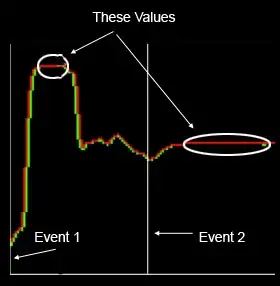This is crossposted from StackOverflow. Someone suggested I should post it here. Though I don't have enough karma to post images.
I'm working with gathering data from a biological monitoring system. They need to know the average value of the plateaus after changes to the system are made.

This is data for about 4 minutes. There is decent lag time between the event and the steady state response.
These values won't always be this level. They want me to find where the steady-state response starts and average the values during that time. My boss, who is a biologist, said there may be overshoot and random fluctuations... and that I might need to use a z-transform. Unfortunately he wasn't more specific than that.
I feel decently competent as a programmer, but wasn't sure what the most efficient way would be to go about finding these values.
Any algorithms, insights or approaches would be greatly appreciated. Thanks.